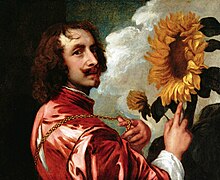
Back Antoon van Dyck Afrikaans Anton van Dyck AN أنطوني فان ديك Arabic فان دايك ARZ Antoon van Dijck AST Antonio Van Deyk Azerbaijani Антонис ван Дейк Bashkir Антоніс ван Дэйк Byelorussian Антоніс ван Дэйк BE-X-OLD Антонис ван Дайк Bulgarian
Anthony van Dyck | |
|---|---|
 Self-Portrait with a Sunflower (after 1633) | |
| Born | Anthonio van Dyck[1] 22 March 1599 |
| Died | 9 December 1641 (aged 42) |
| Nationality | Flemish |
| Education | Hendrick van Balen, Peter Paul Rubens |
| Known for | Painting |
| Movement | Baroque |
| Spouse |
Mary Ruthven (m. 1640) |
| Signature | |
 | |
Sir Anthony van Dyck (/vænˈdaɪk/; Dutch: Antoon van Dyck [ˈɑntoːɱ vɑn ˈdɛik];[a] 22 March 1599 – 9 December 1641)[3] was a Flemish Baroque artist who became the leading court painter in England after success in the Spanish Netherlands and Italy.
The seventh child of Frans van Dyck, a wealthy silk merchant in Antwerp, Anthony painted from an early age. He was successful as an independent painter in his late teens and became a master in the Antwerp Guild on 18 October 1617.[4] By this time, he was working in the studio of the leading northern painter of the day, Peter Paul Rubens, who became a major influence on his work.
Van Dyck worked in London for some months in 1621, then returned to Flanders for a brief time, before travelling to Italy, where he stayed until 1627, mostly in Genoa. In the late 1620s he completed his greatly admired Iconography series of portrait etchings of mainly other artists and other famous contemporaries. He spent five years in Flanders after his return from Italy, and from 1630 was court painter for the Archduchess Isabella, Habsburg Governor of Flanders. At the request of Charles I of England he returned in 1632 to London as the main court painter.
With the exception of Holbein, van Dyck and his contemporary Diego Velázquez were the first painters of pre-eminent talent to work mainly as court portraitists, revolutionising the genre. Van Dyck is best known for his portraits of the aristocracy, most notably Charles I, and his family and associates. He was the dominant influence on English portrait-painting for over 150 years. He also painted mythological, allegorical and biblical subjects, including altarpieces, displayed outstanding facility as a draughtsman, and was an important innovator in watercolour and etching.
His influence extends into the modern period. The Van Dyke beard is named after him. During his lifetime, Charles I granted him a knighthood, and he was buried in St Paul's Cathedral, an indication of his standing at the time of his death.
- ^ Moortgat, Ingrid. “Baptism of Antonio Van Dyck.” In Jordaens Van Dyck Panel Paintings Project. Edited by Joost Vander Auwera and Justin Davies, accessed 21 February 2024
- ^ ULAN entry.
- ^ "Anthony van Dyck". Netherlands Institute of Art. Retrieved 14 February 2024.
- ^ Davies, Justin. 'A new date for Anthony van Dyck's free mastership'. The Burlington Magazine 165 (February 2023), pp. 162–165.
Cite error: There are <ref group=lower-alpha> tags or {{efn}} templates on this page, but the references will not show without a {{reflist|group=lower-alpha}} template or {{notelist}} template (see the help page).